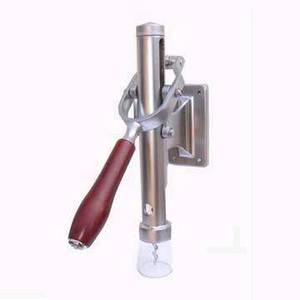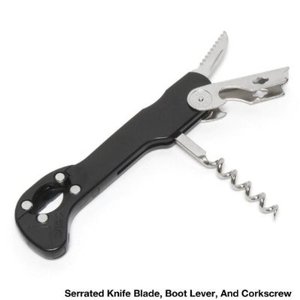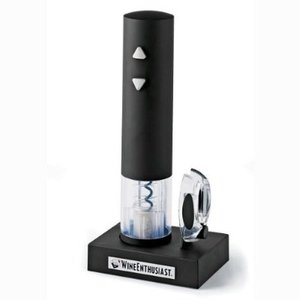It takes a lot of work to get wine into the bottle and sometimes it takes a lot of work to get it back out! Not everyone in the wine industry knows what it takes to make wine, yet everybody seems to have an opinion on the ubiquitous companion of the wine bottle: the corkscrew. Unlike beer bottles, which can be opened by all manner of party tricks, wine bottles require a bit of gadgetry to free the genie (although if you are caught in a tight spot here’s a clever way to open a wine bottle using only a shoe). They come in all shapes and sizes and everyone seems to have their favorite, so I thought I’d weigh in on the long running debate of which is the best corkscrew.
I’m sure that as soon as the cork was invented, people around the world began to devise methods to remove it. In fact so many wonderfully diverse solutions have been developed that there seems to be as many different types of corkscrews as there are wines. I’ve tried to break them down into a couple categories that they fall into:
Heavy Machinery – Anything with a mount falls into this category. Usually these attach to a countertop or wall but sometimes they have their own base to sit on a table top. These typically use a lever design where all you need to do is place the neck under the corkscrew and pull the lever down and then back up and voila!

Cellar Rat Opinion Poll: Obviously the lack of portability kicks them out of the running for top pick but their smooth action is very nice when they’re around. They’re especially useful when you need to open lots of bottles at a bar. I particularly like ones that eject the cork like a shotgun cartridge!
“Houdini” Style Lever Operation – These guys operate using the same mechanism as the Heavy Machinery except that instead of mounting they have arms that grip the bottle. The lever automatically spins the screw into the cork as the handle is pushed down.

Cellar Rat Opinion Poll: I don’t like these at all. They typically offer some smooth operation but they don’t fit in your pocket and are kind of bulky, though companies are beginning to offer some more refined models. Usually they don’t come with foil cutters attached so even though you’ve got this bulky thing, you’ve got to keep track of another gadget.
Double Lever Corkscrew – These are the ones that look kind of like a woman wearing a dress. You place the corkscrew over the neck of the bottle then hand twist the screw which lifts the levers. Pulling down both levers gives you double the leverage for an easy pull.

Cellar Rat Opinion Poll: These are by far my least favorite style and it seems like the idea has been rethought because I’m starting to see them less and less. I’ve never seen a wine professional use one of these on the job. They’re awkward because the arms lift as you screw so you can’t really hold the corkscrew to begin the operation.
The Classic Waiter’s Corkscrew – The quintessential corkscrew. These Swiss Army Knife-like openers fold up to fit in your pocket and almost always have a foil cutter attached. They vary dramatically in quality and ease of use. Some are much better than others and the type of foil cutter also differs depending on the model.

Cellar Rat Opinion Poll: Hands down, a great waiter’s corkscrew is a Cellar Rat’s best friend. Pick carefully though because it’s the subtleties here that make the difference. Quality is key. I’ve had the screw snap off before in the line of duty, which is always embarrassing. I like serrated cutters much more that non-serrated. Also there have been some innovations that have really changed the game. Nowadays, most waiter’s corkscrews have what’s known as a “2-step” operation. This means they have a second notch to gain purchase with so that you don’t have to work as hard to get it started. So far I’ve seen two designs: A hinged approach which I DO NOT recommend as they have the tendency to wear out and to bend inward. I recommend the 2-step that is actually made out of two separate pieces. My favorite is the Metrokane Rabbit Zippity. Funny name but it’s got everything: High quality, durable make? Check. Serrated blade? Check. 2-step, non-hinge lever. Check. Slim and sleek design. Check.
Boomerang Corkscrew – Similar to the waiter’s corkscrew design but they usually don’t have 2-step operation. Instead they feature a moving pivot point to improve the leverage. They are distinctive in that they feature a foil cutter that uses four little discs instead of knife.

Cellar Rat Opinion Poll: While I still prefer the waiter’s version, there are some nice perks to this type of corkscrew. The disc foil cutter is much safer and easier to use than the knife which takes a little technique and practice. I’ve seen many a veteran cut themselves with a knife when moving too fast. Also if you’re trying to get a perfect edge it seems like this type of cutter yields results everytime. If you’re looking for safety (maybe you’ve got kids around) this might be a better choice for you.
Miscellaneous – You might remember those weird corkscrews that aren’t corkscrews at all, but instead have two prongs - low tech and tricky, yet effective. Now they also have electric ones that do all the work for you with the press of a button. I’m sure there are many more unconventional approaches yet to be discovered.

Cellar Rat Opinion Poll: There are some pretty nifty and quirky openers out there but I’d rather have my trusty Zippity than a conversation piece. Until the next great thing comes out I’m relying on my waiter’s corkscrew to get the job done.
The waiter’s corkscrew may be my favorite but I’ll admit that it can require a little finesse. Here's a few tips to use one safely and effectively:
- Put the back of the cutter blade against your thumb and use your forefinger to firmly grip around the neck of the bottle.
- Angle the blade down towards the collar of the bottle (See my "Anatomy of the Bottle" post) and rotate the bottle while applying firm pressure.
- Hold the point of the screw along your extended index finger to precisely guide the point into the cork slightly off center. This way when you begin to twist the screw in it will be centered.
- If you have a 2-step corkscrew make use of the double step! Start with the notch closest to the fulcrum and then move to the one on the end.
- When the cork pops, expect the sudden release tension so that you don't spill the wine by jerking the bottle.
Now you're ready to open bottles like a pro!
